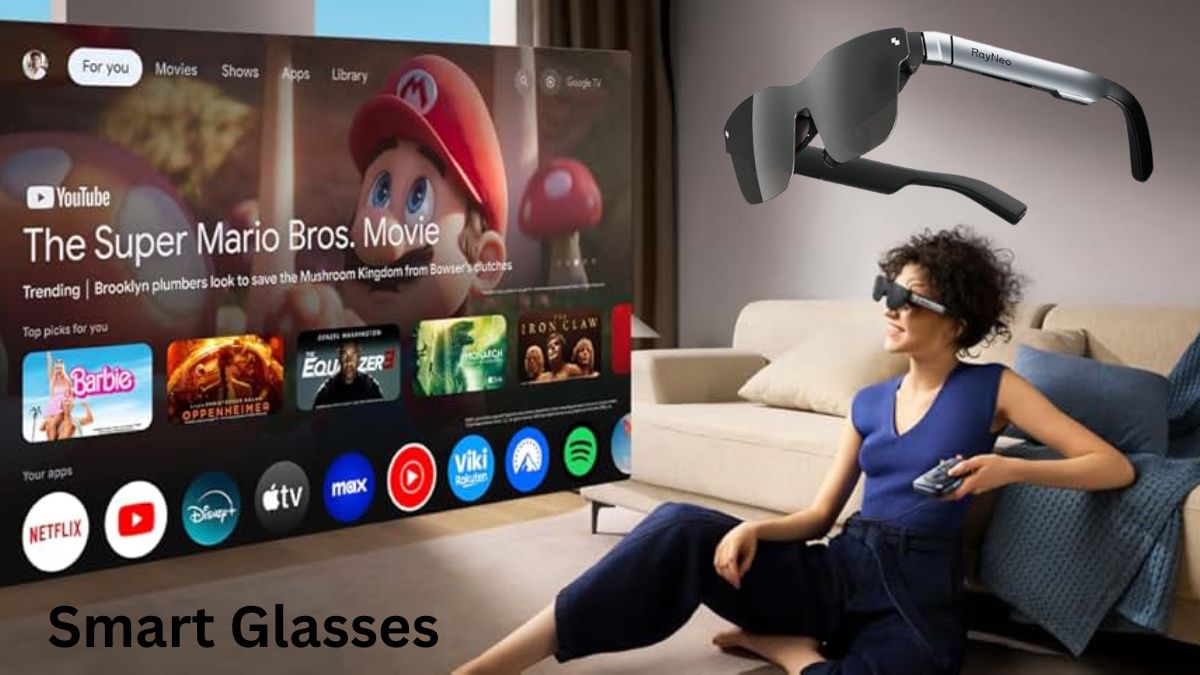Smart Glasses and Wearable Technology in 2025

Introduction
Smart Glasses Wearable technology has become integral to our lives, driving innovation in communication, health monitoring, and personal entertainment. Among these devices, smart glasses are rapidly evolving to provide users with enhanced augmented reality (AR) experiences, hands-free connectivity, and new ways to interact with digital content. In 2025, these devices are reshaping industries, from healthcare and education to gaming and enterprise solutions, making them a key player in the tech landscape.

Evolution of Smart Glasses
- Early Developments and Challenges
Smart glasses first entered the consumer market over a decade ago with ambitious goals but limited functionality. Devices like Google Glass set the stage but faced hurdles such as limited battery life, privacy concerns, and high costs. Early models were often bulky, lacked user-friendly interfaces, and struggled to find mainstream adoption.
- Key Advancements Over the Years
Technological improvements in AR displays, voice recognition, and compact design transformed smart glasses into more practical tools. Companies integrated better processors, lightweight materials, and high-definition displays, making the devices both functional and comfortable.
- Current State in 2025
In 2025, smart glasses have moved beyond their initial limitations, featuring advanced AR overlays, seamless smartphone integration, and AI-driven functionalities. Their designs have evolved to be stylish and comfortable, appealing to both consumers and enterprise markets.
Core Features of Modern Smart Glasses
- Display and AR Capabilities
Modern smart glasses offer transparent, high-resolution displays that blend digital elements with real-world environments. AR overlays provide contextual information, navigation assistance, and interactive experiences for users.
- Hands-Free Communication
With built-in microphones and speakers, users can make calls, send texts, and access digital assistants without needing to touch their phones. This hands-free approach is particularly valuable for busy professionals and on-the-go consumers.
- Health and Fitness Tracking
Many smart glasses now incorporate health sensors, such as heart rate monitors and posture trackers, making them valuable tools for health-conscious users.
- AI-Powered Assistance
AI integration provides real-time language translation, facial recognition, and contextual prompts. Virtual assistants can offer proactive suggestions and automate routine tasks.
Integration with Other Technologies
- Compatibility with Smartphones, IoT, and Cloud Services
Smart glasses seamlessly connect with smartphones and other smart devices, enabling users to control smart homes, manage schedules, and access cloud-based data effortlessly.
- Role in the Metaverse
The rise of the metaverse has made smart glasses essential for immersive virtual experiences. Users can explore digital worlds, attend virtual meetings, and collaborate on projects in shared augmented environments.
- Smart Home and Office Integration
Smart glasses help manage smart home devices through visual interfaces and voice commands. They also support office productivity by facilitating remote work and real-time collaboration.
Applications of Smart Glasses in 2025
- Consumer Market
Consumers use smart glasses for navigation, fitness tracking, photography, and augmented entertainment experiences.
- Business and Enterprise Use
Enterprises leverage these devices for tasks such as remote support, hands-free documentation, and AR-enhanced training.
- Healthcare Advancements
In healthcare, smart glasses assist in telemedicine, remote surgeries, and patient monitoring, improving diagnosis and treatment outcomes.
- Education and Training
Smart glasses provide immersive learning experiences and hands-on training simulations, transforming education delivery.
- Entertainment and Gaming
AR gaming and interactive media experiences are revolutionizing entertainment, offering users new ways to engage with digital content.

Benefits of Smart Glasses
- Increased Productivity
Smart glasses streamline tasks by providing real-time data and instructions directly in the user’s field of view. Workers can access blueprints, assembly instructions, or troubleshooting guides without pausing to check a screen, significantly enhancing productivity.
- Enhanced User Experience in AR and VR
Augmented reality overlays offer an enriched user experience by blending digital content with the physical world. From live translations to interactive gaming, users engage with technology in a seamless, immersive way.
- Improved Health Monitoring
With built-in biometric sensors, smart glasses track heart rate, step count, and posture. Some models even monitor eye strain and provide real-time feedback to promote healthier habits during extended wear.
Privacy and Security Challenges
- Data Collection Concerns
The ability of smart glasses to record video, capture audio, and track location raises privacy issues. Users and bystanders alike worry about unauthorized surveillance or data breaches.
- Solutions to Enhance Privacy
Manufacturers are responding by incorporating visible recording indicators, secure encryption for data storage, and user-controlled privacy settings. Educating consumers on responsible use also plays a vital role in fostering trust.
Future Trends and Innovations
- Integration with AI and Machine Learning
Smart glasses are becoming smarter with AI-driven personal assistants capable of anticipating user needs, providing reminders, and offering real-time solutions based on environmental cues.
- Advancements in AR and Holographic Displays
The next generation of displays is expected to feature advanced AR and holographic technology, delivering life-like 3D projections for navigation, virtual meetings, and interactive entertainment.
- Potential for Brain-Computer Interface (BCI)
Researchers are exploring brain-computer interface technology to enable direct communication between the brain and smart glasses, potentially eliminating the need for voice or touch controls.

Wearable Technology Beyond Smart Glasses
- Smartwatches, Fitness Bands, and Clothing
Wearable tech now extends to smartwatches that track health data, fitness bands for exercise monitoring, and even clothing embedded with sensors to measure movement and body temperature.
- Innovations in Implantable Devices
Implantable technologies, such as smart contact lenses and subdermal health trackers, represent the next frontier, offering even more integrated solutions for monitoring health and enhancing daily life.
Societal Impacts
- Changing Workplace Dynamics
The adoption of smart glasses is transforming how employees perform tasks, collaborate, and communicate. Workers can access real-time data and guidance while maintaining full mobility, leading to more efficient workflows.
- Ethical Considerations
As technology becomes more embedded in daily life, concerns about surveillance, consent, and data privacy intensify. Society must address these issues to ensure ethical deployment.
- Accessibility for Differently-Abled Individuals
Smart glasses offer tremendous potential for enhancing accessibility by providing features such as voice commands, visual aids, and real-time captions for those with hearing or vision impairments.
Challenges Facing the Wearable Tech Industry
- Technological Limitations
Despite advancements, issues like limited battery life, connectivity challenges, and display clarity in bright environments persist.
- Market Adoption Barriers
High costs and the need for extensive user education present obstacles to widespread adoption. Consumers may also be wary of potential privacy risks.
- Cost Concerns
Many wearable technologies remain expensive, limiting access to premium features for a broader audience. Companies are exploring more affordable production methods to address this.
The Competitive Landscape
- Key Players in the Market
Leading tech companies such as Apple, Google, Microsoft, and Meta are driving innovation in the smart glasses space. These firms are continually pushing the boundaries of what wearable tech can achieve.
- Emerging Startups and Innovations
Startups are introducing specialized solutions, such as smart glasses for industrial use or models designed specifically for sports and fitness.
Case Studies: Successful Implementations
- Real-World Use Cases of Smart Glasses
Healthcare: Surgeons use AR-enhanced smart glasses for more precise operations and real-time guidance.
- Manufacturing: Factory workers benefit from hands-free access to assembly instructions.
- Retail: Sales staff utilize smart glasses for inventory management and customer assistance.
- Success Stories in Business, Healthcare, and Education
- Organizations report higher efficiency, reduced errors, and improved training outcomes when integrating smart glasses into their workflows.
Consumer Adoption and Market Forecast
- Current Adoption Rates
Consumer adoption of smart glasses has grown steadily due to increased awareness and improved functionality. Tech-savvy early adopters have paved the way for broader acceptance.
- Predicted Market Growth
Industry experts predict exponential growth in the wearable tech market over the next few years, with smart glasses playing a central role in AR and IoT ecosystems.

Smart Glasses Buying Guide for 2025
Smart glasses have become essential wearable technology in 2025, offering features that blend augmented reality (AR), fitness tracking, and hands-free communication. If you’re considering smart glasses, this guide will help you make an informed decision by highlighting the key factors to consider, top features, and recommendations.
1. Key Factors to Consider
a) Intended Use
Determine your primary purpose for the glasses:
- Everyday Use: Look for models with style, comfort, and essential features like calls and notifications.
- Work and Enterprise: Choose glasses with AR integration, real-time data overlays, and enterprise apps.
- Fitness and Health Tracking: Prioritize models with biometric sensors and health monitoring capabilities.
- Gaming and Entertainment: Opt for high-resolution displays and immersive AR features.
b) Display Technology
- AR Overlays: Transparent displays for real-world information integration.
- Full-Color Holographic Displays: Ideal for enhanced visual experiences in gaming or enterprise environments.
- Heads-Up Displays (HUDs): Useful for navigation and productivity without obstructing your view.
c) Battery Life
- Look for glasses with long battery life (8-12 hours) for extended usage. Quick charging capabilities are a bonus.
d) Comfort and Design
- Lightweight materials and adjustable frames for all-day wear.
- Different styles are available to match personal aesthetics.
- Prescription lens compatibility for users with vision correction needs.
e) Connectivity Options
- Bluetooth and Wi-Fi support for seamless device pairing.
- 5G compatibility for high-speed data access.
f) Privacy and Security
- Built-in encryption for data protection.
- Visible recording indicators to ensure ethical use.
2. Top Features to Look For
a) AR and VR Capabilities
- Real-time navigation, translations, and instructions.
- Interactive gaming and media streaming.
b) Voice and Gesture Controls
- Hands-free operation for tasks such as messaging or accessing apps.
- Intuitive gesture controls for navigating menus and interacting with content.
c) Fitness and Health Tracking
- Heart rate monitors, calorie counters, posture correction.
- Alerts for eye strain and hydration reminders.
d) Camera and Audio
- High-resolution cameras for photos, video recording, and live streaming.
- Bone conduction audio or built-in speakers for immersive sound.
e) App Ecosystem
- Compatibility with major platforms like iOS, Android, and proprietary apps for fitness, productivity, and entertainment.
3. Popular Brands in 2025
a) Apple Vision Pro
- Known for its sleek design and seamless integration with the Apple ecosystem, offering advanced AR features and productivity tools.
b) Meta Quest Glasses
- Focused on immersive VR experiences and gaming, Meta’s smart glasses are ideal for tech enthusiasts.
c) Google Glass Enterprise Edition
- Tailored for industrial and business use, featuring advanced AR overlays and robust security.
d) Xiaomi Smart Wear
- Affordable options with competitive features for everyday users.
e) Bose Frames
- Blending fashion with functionality, these smart glasses offer premium audio without compromising style.
4. Budget Considerations
a) Entry-Level Models
- Price: $200 – $500
- Basic features: notifications, hands-free calling, fitness tracking.
b) Mid-Range Models
- Price: $500 – $1000
- Enhanced AR capabilities, voice assistants, and better battery life.
c) Premium Models
- Price: $1000+
- Advanced holographic displays, enterprise-level features, and full integration with AR and VR platforms.
5. Pros and Cons of Smart Glasses
Pros
- Hands-free access to information.
- Enhanced productivity and immersive AR experiences.
- Improved health monitoring and fitness tracking.
Cons
- Potential privacy concerns.
- Battery life may be limited in high-performance models.
- Higher cost compared to other wearable tech.
6. Tips for First-Time Buyers
- Try Before You Buy: Test models in stores or through virtual try-ons to ensure comfort and suitability.
- Consider Ecosystem Compatibility: Choose glasses that integrate well with your existing devices.
- Check Battery Life Ratings: Select models that align with your daily usage needs.
- Look for Software Updates: Opt for brands that provide regular software enhancements to improve features and security.
7. Maintenance and Care
- Cleaning: Use microfiber cloths for cleaning lenses and AR displays.
- Storage: Keep glasses in a protective case when not in use.
- Software Updates: Regularly update firmware for improved performance and security.
Smart glasses are revolutionizing the way we experience technology. By carefully considering your needs, budget, and the features most important to you, you can find the perfect pair of smart glasses to enhance your daily life. Whether for work, fitness, or entertainment, there’s a model designed to meet your unique requirements.

FAQs
1. What are smart glasses used for in 2025?
Smart glasses are used for hands-free communication, augmented reality experiences, fitness tracking, professional tasks, and real-time information access.
2. Are smart glasses safe to wear for extended periods?
Yes, most modern smart glasses are designed for prolonged use with features to reduce eye strain and improve comfort.
3. How do smart glasses connect to other devices?
They typically connect via Bluetooth or Wi-Fi, allowing seamless integration with smartphones, IoT devices, and cloud services.
4. What are the major brands offering smart glasses today?
Leading brands include Apple, Google, Microsoft, Meta, and several specialized tech startups.
5. Will smart glasses replace smartphones?
While they complement smartphones and other devices, they are unlikely to completely replace them shortly.

Conclusion
Smart glasses and wearable technology are rapidly transforming how we interact with the world around us. With applications spanning entertainment, healthcare, business, and personal productivity, these devices represent the next frontier in digital innovation. As challenges related to privacy, cost, and adoption are addressed, the future of smart glasses appears brighter than ever.
You can see Tips for Buying Quality Best 10 Cool Gadgets Under $50. Maybe you like it. Details Here



